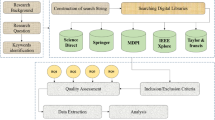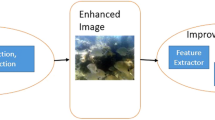Abstract
Side-scan sonar is a valuable tool for mapping habitat features in many aquatic systems suggesting it may also be useful for locating sedentary biota. The objective of this study was to determine if side-scan sonar could be used to identify freshwater mussel (unionid) beds and the required environmental conditions. We used side-scan sonar to develop a series of mussel-bed reference images by placing mussel shells within homogenous areas of fine and coarse substrates. We then used side-scan sonar to map a 32-km river reach during spring and summer. Using our mussel-bed reference images, several river locations were identified where mussel beds appeared to exist in the scanned images and we chose a subset of sites (n = 17) for field validation. The validation confirmed that ~60% of the sites had mussel beds and ~80% had some mussels or shells present. Water depth was significantly related to our ability to predict mussel-bed locations: predictive ability was greatest at depths of 1–2 m, but decreased in water >2-m deep. We determined side-scan sonar is an effective tool for preliminary assessments of mussel presence during times when they are located at or above the substrate surface and in relatively fine substrates excluding fine silt.



Similar content being viewed by others
References
Allen, D. C. & C. C. Vaughn, 2009. Burrowing behavior of freshwater mussels in experimentally manipulated communities. Journal of the North American Benthological Society 28: 93–100.
Allison, P., 1999. Logistic Regression Using the SAS System. SAS Institute. Inc., Cary.
Beasley, C. R. & D. Roberts, 1996. The current distribution and status of the freshwater pearl mussel Margaritifera margaritifera L 1758 in north-west Ireland. Aquatic Conservation-Marine and Freshwater Ecosystems 6: 169–177.
Bódis, E., B. Tóth & R. Sousa, 2014. Massive mortality of invasive bivalves as a potential resource subsidy for the adjacent terrestrial food web. Hydrobiologia 735: 253–262.
Bovee, K. D. & T. Cochnauer. 1977. Development and evaluation of weighted criteria, probability-of-use curves for instream flow assessments: fisheries. Instream Flow Information Paper, US Fish and Wildlife Service: 53 pp.
Christian, A. D. & J. L. Harris, 2005. Development and assessment of a sampling design for mussel assemblages in large streams. American Midland Naturalist 153: 284–292.
Collier, J. S. & C. J. Brown, 2005. Correlation of sidescan backscatter with grain size distribution of surficial seabed sediments. Marine Geology 214: 431–449.
Colombet, I., M. C. Jaulent, P. Degoulet & G. Chatellier, 2001. Logistic regression model: an assessment of variability of predictions. Studies in Health Technology and Informatics 84: 1314–1318.
Dartnell, P. & J. V. Gardner, 2004. Predicting seafloor facies from multibeam bathymetry and backscatter data. Photogrammetric Engineering and Remote Sensing 70: 1081–1091.
Degraer, S., V. Van Lancker, G. Moerkerke, G. Van Hoey, K. Vanstaen, M. Vincx, & J.-P. Henriet. 2003. Evaluation of the ecological value of the foreshore: habitat-model and macrobenthic side-scan sonar interpretation: extension along the Belgian Coastal Zone. Final report. Ministry of the Flemish Community, Environment and Infrastructure. Department. Waterways and Marine Affairs Administration, Coastal Waterways.
Edsall, T. A., G. W. Kennedy & W. H. Horns, 1993. Distribution, abundance, and resting microhabitat of burbot on Julian’s Reef, southwestern Lake Michigan. Transactions of the American Fisheries Society 122: 560–574.
Field, A. & J. Miles, 2010. Discovering Statistics Using SAS. SAGE Publications, London.
Fish, J. P. & H. A. Carr, 1990. Sound Underwater Images: A Guide to the Generation and Interpretation of Side Scan Sonar Data. Lower Cape Publishing, Orleans.
Fish, J. P. & H. A. Carr, 2001. Sound Reflections: Advanced Applications of Side Scan Sonar. Lower Cape PubPublishing, Orleans.
Galbraith, H. S. & C. C. Vaughn, 2009. Temperature and food interact to influence gamete development in freshwater mussels. Hydrobiologia 636: 35–47.
Gordon, N. D., 2004. Stream Hydrology: An Introduction for Ecologists. Wiley, New York.
Graf, D. L. & D. Ó. Foighil. 2000. The evolution of brooding characters among the freshwater pearly mussels (Bivalvia: Unionoidea) of North America. Journal of Molluscan Studies 66: 157–170.
Graham, M. H., 2003. Confronting multicollinearity in ecological multiple regression. Ecology 84: 2809–2815.
Haag, W. R., 2012. North American Freshwater Mussels: Natural History, Ecology, and Conservation. Cambridge University Press, Cambridge.
Haltuch, M. A., P. A. Berkman & D. W. Garton, 2000. Geographic information system (GIS) analysis of ecosystem invasion: Exotic mussels in Lake Erie. Limnology and Oceanography 45: 1778–1787.
Hartstein, N. D., 2005. Acoustical and sedimentological characterization of substrates in and around sheltered and open-ocean mussel aquaculture sites and its bearing on the dispersal of mussel debris. Ieee Journal of Oceanic Engineering 30: 85–94.
Hastie, L. C. & P. J. Cosgrove, 2002. Intensive searching for mussels in a fast-flowing river: an estimation of sampling bias. Journal of Conchology 37: 309–316.
Hewitt, J. E., S. E. Thrush, P. Legendre, G. A. Funnell, J. Ellis & M. Morrison, 2004. Mapping of marine soft-sediment communities: integrated sampling for ecological interpretation. Ecological Applications 14: 1203–1216.
Hobbs, C. H., 1985. Side-scan sonar as a tool for mapping spatial variations in sediment type. Geo-Marine Letters 5: 241–245.
Hook, J. D., 2011. Sturgeon Habitat Quantified by Side-Scan Sonar Imagery. University of Georgia, Athens.
Howard, J. K. & K. M. Cuffey, 2006. The functional role of native freshwater mussels in the fluvial benthic environment. Freshwater Biology 51: 460–474.
Isom, B. G. & C. Gooch, 1986. Rationale for Sampling and Interpretation of Ecological Data in the Assessment of Freshwater Ecosystems. Astm Special Technical Publications, Philadelphia.
Kaeser, A. J. & T. L. Litts, 2008. An assessment of deadhead logs and large woody debris using side scan sonar and field surveys in streams of southwest Georgia. Fisheries 33: 589–597.
Kaeser, A. J. & T. L. Litts, 2010. A novel technique for mapping habitat in navigable streams using low-cost side scan sonar. Fisheries 35: 163–174.
Kaeser, A. J., T. L. Litts & T. Tracy, 2012. Using low-cost side-scan sonar for benthic mapping throughout the Lower Flint River, Georgia. River Research and Applications, USA.
Lopes-Lima, M., A. Teixeira, E. Froufe, A. Lopes, S. Varandas & R. Sousa, 2014. Biology and conservation of freshwater bivalves: past, present and future perspectives. Hydrobiologia 735: 1–13.
Master, L. L., B. A. Stein, L. S. Kutner & G. A. Hammerson, 2000. Vanishing assets: conservation status of US species. In Stein, B. A., L. S. Kutner & J. S. Adams (eds), Precious Heritage: The Status of Biodiversity in the United States. Oxford University Press, Oxford: 93–118.
McRae, S., J. D. Allan & J. Burch, 2004. Reach-and catchment-scale determinants of the distribution of freshwater mussels (Bivalvia: Unionidae) in south-eastern Michigan, USA. Freshwater Biology 49: 127–142.
Metcalfe-Smith, J. L., J. Di Maio, S. K. Staton & G. L. Mackie, 2000. Effect of sampling effort on the efficiency of the timed search method for sampling freshwater mussel communities. Journal of the North American Benthological Society 19: 725–732.
Miller, A. C. & B. S. Payne, 1993. Qualitative versus quantitative sampling to evaluate population and community characteristics at a large-river mussel bed. American Midland Naturalist 130: 133–145.
Naimo, T. J., 1995. A review of the effects of heavy metals on freshwater mussels. Ecotoxicology 4: 341–362.
National Native Mussel Conservation Committee, 1998. National strategy for the conservation of native freshwater mussels. Journal of Shellfish Research 17: 1419–1428.
Neves, R. J. 1993. A state-of-the-unionids address. Proceedings of the UMRCC Symposium on the Conservation and Management of Freshwater Mussels.
Newton, R. & A. Stefanon, 1975. Application of side-scan sonar in marine biology. Marine Biology 31: 287–291.
Pigg, J., 1977. A survey of the fishes of the Muddy Boggy River in south central Oklahoma. Oklahoma Academy of Science 57: 68–82.
Smith, D. R., R. F. Villella & D. P. Lemarie, 2003. Application of adaptive cluster sampling to low-density populations of freshwater mussels. Environmental and Ecological Statistics 10: 7–15.
Sousa, R., S. Varandas, R. Cortes, A. Teixeira, M. Lopes-Lima, J. Machado & L. Guilhermino, 2012. Massive die-offs of freshwater bivalves as resource pulses. Annales de Limnologie 48: 105–112.
Strayer, D. L., 2008. Freshwater Mussel Ecology: A Multifactor Approach to Distribution and Abundance. University of California Press, Oakland.
Teixeira, J. B., A. S. Martins, H. T. Pinheiro, N. A. Secchin, R. L. de Moura & A. C. Bastos, 2013. Traditional ecological knowledge and the mapping of benthic marine habitats. Journal of Environmental Management 115: 241–250.
Tiemann, J. S., S. E. McMurray, M. C. Barnhart & G. T. Watters, 2011. A review of the interactions between catfishes and freshwater mollusks in North America. American Fisheries Society Symposium 77: 733–743.
Toweill, D. E., 1974. Winter food habits of river otters in western Oregon. The Journal of Wildlife Management 38: 107–111.
Tyrrell, M. & D. J. Hornbach, 1998. Selective predation by muskrats on freshwater mussels in two Minnesota rivers. Journal of the North American Benthological Society 17: 301–310.
Vaughn, C. C. & C. C. Hakenkamp, 2001. The functional role of burrowing bivalves in freshwater ecosystems. Freshwater Biology 46: 1431–1446.
Vaughn, C. C., K. B. Gido & D. E. Spooner, 2004. Ecosystem processes performed by unionid mussels in stream mesocosms: species roles and effects of abundance. Hydrobiologia 527: 35–47.
Williams, J. D., M. L. Warren Jr, K. S. Cummings, J. L. Harris & R. J. Neves, 1993. Conservation status of freshwater mussels of the United States and Canada. Fisheries 18: 6–22.
Acknowledgments
This research is a contribution of the Oklahoma Cooperative Fish and Wildlife Research Unit (U.S. Geological Survey, Oklahoma Department of Wildlife Conservation, Oklahoma State University, and Wildlife Management Institute cooperating). Project funding was provided by the Oklahoma Department of Wildlife Conservation (F11AF00027). Any use of trade, firm, or product names is for descriptive purposes and does not imply endorsement by the U.S. Government. We thank Mark Jensen, Bruce Burkehead, and Daniel Beatie for valuable field assistance and Mark Gregory for technical assistance. Dan Shoup and Timothy Grabowski provided valuable comments on an earlier draft.
Author information
Authors and Affiliations
Corresponding author
Additional information
Handling editor: Beat Oertli
Rights and permissions
About this article
Cite this article
Powers, J., Brewer, S.K., Long, J.M. et al. Evaluating the use of side-scan sonar for detecting freshwater mussel beds in turbid river environments. Hydrobiologia 743, 127–137 (2015). https://doi.org/10.1007/s10750-014-2017-z
Received:
Revised:
Accepted:
Published:
Issue Date:
DOI: https://doi.org/10.1007/s10750-014-2017-z




